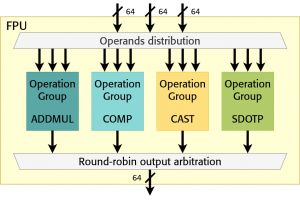Difference between revisions of "Fault-Tolerant Floating-Point Units (M)"
From iis-projects
Lbertaccini (talk | contribs) (Created page with "<!-- Fault-Tolerant Floating-Point Units (M) --> Category:Digital Category:Acceleration_and_Transprecision Category:High Performance SoCs Category:Computer Arch...") |
Lbertaccini (talk | contribs) |
||
| Line 23: | Line 23: | ||
| − | + | Fault-tolerant features are crucial in critical and hostile environments (automotive, space, …). The goal of this project is to enhance the FP unit (FPU) developed at IIS [1] with fault-tolerant features (such as redundancy schemes [2]). | |
| − | |||
| − | |||
== Character == | == Character == | ||
| Line 41: | Line 39: | ||
= References = | = References = | ||
| − | [1 | + | [1] https://github.com/pulp-platform/cvfpu |
| − | |||
| − | |||
| − | [ | + | [2] https://arxiv.org/abs/2303.08706 |
Revision as of 19:25, 3 November 2023
Contents
Overview
Status: Available
- Type: Master Thesis
- Professor: Prof. Dr. L. Benini
- Supervisors:
Introduction
Fault-tolerant features are crucial in critical and hostile environments (automotive, space, …). The goal of this project is to enhance the FP unit (FPU) developed at IIS [1] with fault-tolerant features (such as redundancy schemes [2]).
Character
- 20% Literature / architecture review
- 40% RTL implementation
- 40% Evaluation
Prerequisites
- Strong interest in computer architecture
- Experience with digital design in SystemVerilog as taught in VLSI I
- Experience with ASIC implementation flow (synthesis) as taught in VLSI II
